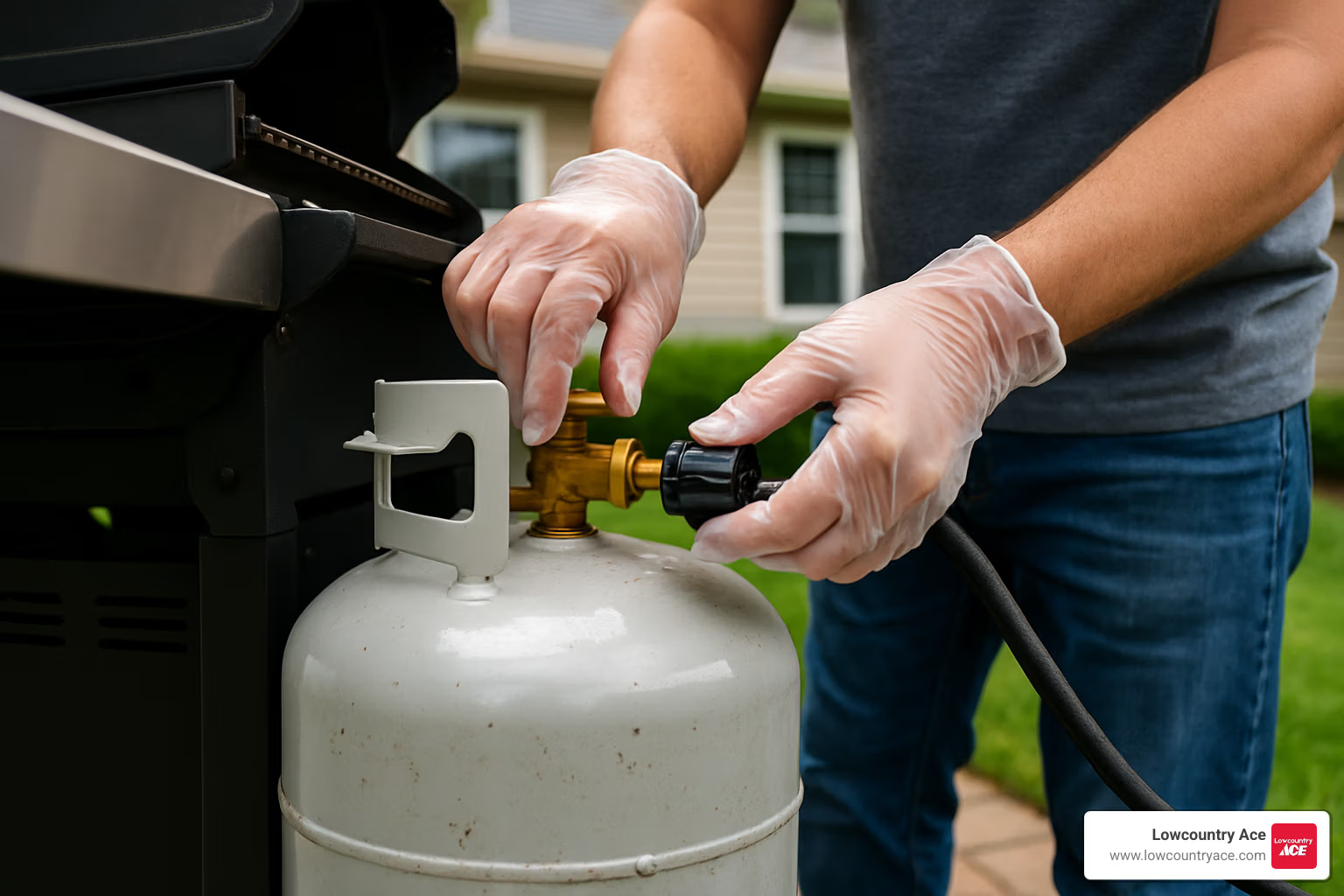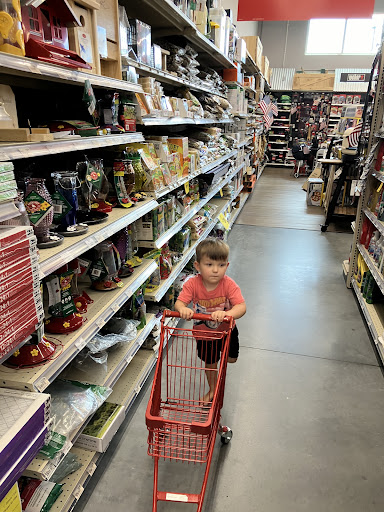Propane Tank Replacement: 7 Essential Safety Tips for 2025
Why Propane Tank Replacement Matters for Your Safety
Propane tank replacement is a critical safety task that every homeowner needs to understand. Whether you’re firing up the grill for a backyard barbecue or keeping your patio heater running through cool Charleston evenings, knowing when and how to replace your propane tank can prevent dangerous situations and keep your family safe.
Quick Answer: When to Replace Your Propane Tank
– Age: Replace after 12 years from manufacture date (stamped on collar)
– Visible damage: Rust, dents, or corrosion on tank surface
– Performance issues: Yellow flames, pilot lights won’t stay lit, or higher bills
– Safety concerns: Rotten egg smell or hissing sounds near tank
– Failed inspection: Tank doesn’t pass recertification test
Most propane tanks last 10 to 30 years depending on type and maintenance. Portable grill tanks must be replaced or recertified every 12 years, while larger stationary tanks can last up to 30 years with proper care.
The warning signs are clear once you know what to look for. As one industry expert noted: “Even the most resilient of things have an expiry date, so you need to check your propane tank regularly for signs of damage.”
From rust and corrosion to strange smells and flame color changes, your tank will tell you when it’s time for a replacement. The key is learning to read these signals before they become safety hazards.
As part of the helpful team at Lowcountry Ace, I’ve guided countless Charleston-area homeowners through safe propane tank replacement procedures and maintenance practices. My experience in strategic consulting and customer education has shown me that proper tank management prevents emergencies and saves money in the long run.
Know your propane tank replacement terms:
– 20 pound propane tank exchange near me
– propane exchange delivery
How Long Does a Propane Tank Last? Codes, Dates & Lifespan Facts
Your propane tank has been faithfully serving your grilling trips for years, but like all good things, it won’t last forever. Understanding how long these sturdy pressure vessels can safely operate isn’t just about getting your money’s worth—it’s about keeping your family safe.
The 12-year rule is the golden standard for portable propane tanks. This isn’t a manufacturer’s suggestion or marketing ploy—it’s federal law. After 12 years from the manufacture date, your trusty grill tank must either be replaced or go through recertification to continue safe operation. Think of it as a mandatory health checkup for your tank.
But here’s where it gets interesting: not all propane tanks follow the same timeline. Above-ground stationary tanks can serve your home for over 30 years with proper care, while underground tanks typically last 20-30 years. The difference comes down to what Mother Nature throws at them and how well you maintain them.
The science behind these timeframes isn’t arbitrary. Corrosion science tells us that metal fatigue, temperature cycling, and environmental exposure gradually weaken tank walls. NFPA 58 (the National Fire Protection Association standard) sets service intervals based on decades of safety data and real-world performance.
Finding the Date & Certification Marks
Every propane tank carries its own birth certificate right on the collar stamp. Look for a date in MM-YY format—this simple marking tells you exactly when your tank was born. If you see “08-19,” that means August 2019, so replacement time would roll around in August 2031.
Don’t stop at the date stamp, though. Your tank’s collar also displays other crucial information that the helpful team at Lowcountry Ace can help you decode. The OPD valve marking indicates your tank has modern overfill prevention technology. You’ll also find the tare weight (how much the empty tank weighs) and water capacity markings.
Sometimes tanks have a visual tag hanging from the valve area. This might show recertification dates or inspection records. These aren’t just bureaucratic paperwork—they’re your safety roadmap for responsible tank ownership.
Recertification Options & Intervals
When your 12-year birthday approaches, propane tank replacement isn’t your only option. Professional recertification can give your tank a new lease on life, though it comes with different time extensions based on the testing method used.
A 5-year extension typically involves visual inspection and valve replacement. The 7-year option includes ultrasonic wall thickness testing to check for internal corrosion. For the full 12-year extension, your tank undergoes rigorous hydrostatic testing—essentially a stress test where the tank is filled with water and pressurized beyond normal operating levels.
Here’s the reality check: recertification often costs nearly as much as buying a new tank. Plus, visual inspection can reveal problems that make recertification impossible anyway. Most homeowners find that starting fresh with a new tank gives them peace of mind and updated safety features.
Above-Ground vs Underground Expectations
Above-ground tanks face Charleston’s humid summers, occasional winter freezes, and everything from salt air to afternoon thunderstorms. Despite this exposure, they can reach that impressive 30-year potential because you can easily inspect them for problems.
Underground tanks play by different rules. They’re protected from weather extremes but battle soil moisture, chemical runoff, and the challenge of limited inspection access. Modern underground installations often include cathodic protection—an electrical system that prevents corrosion by making the tank less attractive to rust-causing chemical reactions.
The key difference is visibility. Above-ground tanks let you spot problems early, while underground issues can hide until they become serious. Either way, regular professional inspections keep your propane system running safely for decades.
Propane Tank Replacement Safety Checklist
Your propane tank is constantly trying to tell you something. The trick is learning its language before a whisper becomes a shout. Propane tank replacement isn’t just about following rules—it’s about keeping your family safe and your equipment running smoothly.
Think of your tank as a hardworking friend who’s been carrying heavy loads for years. Eventually, that friend starts showing signs of wear and tear. Maybe they’re moving a little slower, making strange noises, or just not performing like they used to. Your propane tank does the same thing, and recognizing these signals early can save you from dangerous situations and unexpected emergencies.
According to scientific research on leak detection, aging tanks struggle to maintain optimal pressure, which drives up your propane consumption and costs. When multiple appliances start acting up at the same time, the culprit is usually your tank, not each individual appliance.
Visual Red Flags: Rust, Corrosion & Dents
Here in the Charleston area, our beautiful coastal location comes with a hidden cost—salt air that loves to nibble away at metal surfaces. The helpful team at Lowcountry Ace sees this challenge daily with customers from James Island and Folly Beach who deal with accelerated corrosion.
Surface rust might look scary, but it’s not always a death sentence for your tank. However, it’s definitely your tank’s way of saying “pay attention to me!” When you spot rust that goes deeper than the paint, it’s time to take action. Discoloration around the tank body often signals chemical reactions happening beneath the surface.
Dents and bulges are more serious concerns because they compromise the tank’s structural integrity. Your propane tank is designed to handle specific pressures, and any shape changes can create weak spots. Paint flaking might seem cosmetic, but it exposes bare metal to moisture and accelerates the aging process.
Don’t forget to check around the valve and fitting areas where connections happen. These spots work hard every time you hook up or disconnect your tank, and they’re prime locations for wear and tear.
Performance Clues: Yellow Flames & Failing Pilots
Your appliances are like canaries in a coal mine—they’ll warn you about tank problems before you can see them. A healthy propane flame burns blue with maybe just a hint of yellow at the tip. When flames consistently turn yellow, orange, or red across multiple appliances, your tank is struggling to deliver proper pressure.
Pilot lights that won’t stay lit or frequently go out are another telltale sign. If you find yourself constantly relighting pilots or dealing with reduced heating efficiency that makes cooking take forever, your tank might be on its last legs. Inconsistent flame sizes even with steady gas settings indicate pressure regulation problems.
Perhaps most frustrating are those higher utility bills that creep up despite unchanged usage patterns. When your tank can’t maintain proper pressure, your appliances work harder and consume more fuel to deliver the same results.
Smells & Sounds: Rotten Eggs or Hissing
Propane manufacturers add ethyl mercaptan—a chemical that smells like rotten eggs or skunk spray—specifically so you can detect leaks. It’s not a pleasant smell, but it’s a lifesaving one. Any persistent rotten egg odor near your tank means gas is escaping somewhere it shouldn’t be.
Hissing or whistling sounds are equally serious warning signs. These noises usually happen at connection points, valves, or areas where the tank’s integrity has been compromised. Your ears might detect a leak before your nose does, especially in windy conditions.
If you notice either smell or sound, don’t try to be a hero. Evacuate the area immediately and shut off the main tank valve only if you can do so safely. Call 911 and your propane supplier right away. Avoid any ignition sources including electrical switches, vehicles, or even flashlights. Stay upwind from the tank until professionals arrive to assess the situation.
When Propane Tank Replacement Is Required By Law
Sometimes propane tank replacement isn’t a choice—it’s the law. Federal regulations through the Department of Transportation (DOT) and Transport Canada (TC) establish these rules to prevent accidents and protect public safety. These aren’t suggestions you can ignore when convenient.
Expired certification beyond the 12-year limit makes your tank legally unusable. Failed recertification testing that shows structural weakness means replacement is your only option. Recalled tank models with known safety defects must be replaced immediately, regardless of age or apparent condition.
Some refill stations will simply refuse service to expired tanks, effectively forcing replacement. This policy protects both customers and businesses from liability associated with unsafe containers. It might seem inconvenient, but it’s designed to keep everyone safe.
DIY vs Professional Propane Tank Replacement
Tank exchange and small cylinder replacement are perfect DIY projects for most homeowners. Swapping out a grill tank is straightforward and safe when you follow proper procedures. However, larger stationary tank replacement requires professional installation from licensed technicians who understand local codes and safety requirements.
Professional installation covers permit acquisition for stationary tank placement, proper foundation preparation for stable installation, and code-compliant connections that meet fire department requirements. They’ll also handle pressure testing to verify system integrity and safety inspections before you start using your new tank.
For portable grill tanks, DIY replacement saves money and gives you immediate satisfaction. But any work involving gas lines, regulators, or permanent connections should be left to certified professionals. The helpful team at Lowcountry Ace can help you determine which approach makes sense for your specific situation.
Exchange, Refill or Lease? Choosing the Best Option for Your Home
When it comes to propane tank replacement, you’ve got three solid paths to choose from. Each one serves different lifestyles and budgets, so let’s break down what works best for your Charleston-area home.
Think of it this way: exchange is like grabbing takeout when you’re hungry now, refilling is like cooking at home to save money, and leasing is like having a personal chef handle everything. All three get the job done, but your choice depends on what matters most to you.
More info about Best Place for Propane Exchange
Quick & Easy: Tank Exchange
Tank exchange is the grab-and-go option that busy homeowners love. You roll up with your empty tank, swap it for a full one, and you’re back to grilling in minutes. No waiting around, no wondering if your old tank is still safe to use.
The beauty of exchange lies in the peace of mind factor. Every tank you receive has been professionally inspected and tested. You’re guaranteed a cylinder that meets current safety standards and hasn’t been sitting in someone’s garage for who-knows-how-long.
24/7 availability makes exchange perfect for those last-minute barbecues or when you run out of gas mid-cookout. Many locations keep exchange kiosks stocked around the clock, so you’re never stuck with cold burgers and disappointed guests.
The trade-off is simple: you’ll pay a bit more per gallon, and exchange tanks typically hold 15 pounds of propane instead of the full 20-pound capacity. But for most weekend grillers, that extra convenience is worth every penny.
Budget Friendly: Refilling Your Own Cylinder
If you’re the type who counts every dollar and uses propane regularly, refilling your own tank makes the most financial sense. You’ll get the best per-gallon value and maximize your fuel investment.
More info about Propane Refills Near Me
Refilling gives you the full 20-pound capacity your tank was designed for, which means more grilling time between fills. You also get to keep using your own equipment—handy if you’ve got a tank you trust or one with special features.
The catch is that your tank needs to pass inspection every time. If it’s showing rust, dents, or approaching its expiration date, the refill station might refuse service. That’s when you’ll need to consider propane tank replacement through exchange instead.
Environmental benefits make refilling appealing too. You’re reducing the cycling of tanks through the system and getting maximum use from your existing equipment.
Hassle-Free: Leasing a Stationary Tank
For homes that use propane for heating, cooking, and outdoor living, leasing a stationary tank shifts all the headaches to someone else. This option works especially well for whole-house propane systems or when you’re tired of managing portable cylinders.
Professional maintenance comes included with most lease agreements. Your supplier handles inspections, repairs, and eventual replacement when the time comes. Wireless monitoring systems can even alert your supplier when you’re running low, preventing those awkward moments when the hot water goes cold mid-shower.
Emergency service gives you a safety net for urgent situations, and no upfront tank costs make this option attractive if you don’t want to invest in equipment you’ll eventually need to replace anyway.
The helpful team at Lowcountry Ace can walk you through the math to see if leasing makes sense for your specific usage patterns. Sometimes the convenience factor alone justifies the higher long-term costs, especially for busy families or folks who travel frequently.
Your choice really comes down to how you live and what you value most. Quick convenience, budget savings, or total hands-off management—all three paths lead to safe, reliable propane service for your home.
Safe Removal, Disposal & Installation Steps
When it’s time for propane tank replacement, doing it safely protects everyone around you—and it’s really not as complicated as you might think. The key is taking your time and following the right steps in order. Whether you’re swapping out a small grill tank or dealing with a larger setup, these procedures will keep you safe while being kind to the environment.
The helpful team at Lowcountry Ace has guided countless Charleston-area homeowners through this process. We’ve seen what happens when people rush or skip steps—it’s just not worth the risk. Take a deep breath, gather your tools, and let’s walk through this together.
Shut-Off, Purge & Disconnect
Think of this step as putting your propane system to sleep safely. Start by shutting off all appliances that use the tank—your grill, patio heater, or whatever you’ve got connected. Then turn the main valve on the tank itself clockwise until it stops. You’ll hear a slight change in sound when it’s fully closed.
Now comes the purging part, which sounds fancy but is actually simple. Turn on one of your appliances briefly to burn off any gas still in the lines. The flame will sputter and die as the remaining propane gets used up. This step prevents gas from escaping when you disconnect everything.
Let everything cool down completely before you start unscrewing connections. Hot metal and gas fittings don’t mix well, and you’ll get a better grip on everything once it’s cooled off. When you do start disconnecting, turn fittings slowly and steadily—no sudden movements that could cause gas to rush out.
Transport & Storage Best Practices
Here’s where a lot of people make mistakes without realizing it. Always keep propane tanks upright during transport and storage. Think of it like carrying a full coffee cup—you wouldn’t tip it sideways, right? Same principle applies here, but with much higher stakes.
Secure your tank in the truck bed or trailer with straps or bungee cords, but don’t crank them down so tight that you dent the tank. You want it snug and stable, not squeezed. Never put propane tanks inside your car or truck cab—they need fresh air circulation, and enclosed spaces can become dangerous quickly.
Drive straight to your destination and get that tank out of your vehicle as soon as you arrive. Charleston’s heat can build up fast, especially in summer, and that raises the pressure inside the tank beyond safe levels. Your tank will thank you for the quick trip.
Environmentally Responsible Disposal
Old propane tanks can’t just go in your regular trash—they need special handling to protect our beautiful Lowcountry environment. Contact your local household hazardous waste center to find out when they’re accepting propane cylinders. These events happen regularly around Charleston, and they’re usually free.
Before you take your tank anywhere for disposal, make sure it’s completely empty and remove the valve if possible. Some scrap metal yards will take empty tanks, but call ahead first. They’ll tell you exactly how they want the tank prepared.
Many propane suppliers, including us at Lowcountry Ace, offer recycling programs where we’ll take your old tank when you get a new one. It’s convenient for you and ensures the tank gets handled properly. Win-win.
Installing & Testing the New Tank
Installing your new tank is like putting together a puzzle—everything has its place, and when it’s right, you’ll know it. Position your tank on level, stable ground away from any heat sources or building openings. You want easy access for future maintenance, but also enough clearance to shut things off quickly if needed.
When you’re connecting the gas lines, take your time with each fitting. Hand-tighten first, then use a wrench for the final turn or two. Don’t over-tighten—snug is good, gorilla-tight is bad.
Here’s the most important part: test everything with soapy water before you fire up your grill. Mix up some dish soap and water in a spray bottle and spray every connection. If you see bubbles forming, you’ve got a leak that needs fixing before you use the system.
Remember the 80% fill rule—never fill your tank completely full. That extra 20% gives the propane room to expand when it gets hot, preventing dangerous pressure buildup. Most professional fill stations know this rule, but it’s good to understand why your “full” tank isn’t actually 100% full.
Right-Size Your New Tank & Keep It Healthy
Choosing the right tank size for your propane tank replacement feels a bit like buying shoes—you want something that fits your needs perfectly without being too big or too small. The helpful team at Lowcountry Ace has guided countless Charleston-area homeowners through this decision, and we’ve learned that the right size depends on how you actually use propane, not just what looks good on paper.
Think about your typical propane usage over a month. Do you fire up the grill every weekend, or are you more of a special-occasion griller? Do you have multiple propane appliances running, or just that trusty old Weber? Your honest usage patterns will guide you to the perfect tank size.
Common Propane Tank Sizes & Uses
Small 16-ounce cylinders work great for tabletop grills and camping trips, but they’re like buying milk in single-serving containers—convenient but expensive if you use propane regularly. These little powerhouses are perfect for your portable camping stove or that cute tabletop grill on your apartment balcony.
The 20-pound tank has earned its reputation as America’s favorite for good reason. Holding just under five gallons of propane, it powers most residential grills through an entire season of weekend barbecues. It’s heavy enough to stay put in Charleston’s coastal breezes but light enough for most people to handle safely.
30-pound tanks offer that sweet spot for serious grillers and RV enthusiasts. With around seven gallons of capacity, they’ll keep your large grill running through extended cookouts and family reunions. These tanks work especially well if you’re running multiple propane appliances or planning extended camping trips around the beautiful South Carolina coast.
For whole-house applications like indoor fireplaces or backup generators, 100-pound tanks become the practical choice. These tanks hold nearly 25 gallons and require permanent installation, but they provide weeks or months of service between refills. They’re particularly popular with James Island residents who rely on propane for primary heating or cooking.
Maintenance Hacks to Extend Tank Life
Your propane tank will reward good care with years of reliable service. Regular visual inspections catch small problems before they become expensive replacements—just like checking your car’s oil prevents engine trouble down the road.
Keep your tank painted to fight off rust, especially here in our salty coastal air. When you spot paint chips or scratches, touch them up promptly with quality metal primer and paint. Think of paint as your tank’s sunscreen—it prevents the damage that leads to premature aging.
Clear vegetation around your tank regularly. Weeds and bushes don’t just look messy—they can trap moisture against the tank surface and block important inspection access. Maintain at least three feet of clearance, which also happens to be what our local fire codes require.
For underground tanks, monitor cathodic protection systems annually. These clever electrical systems fight soil corrosion, but they need professional testing to ensure they’re working properly. It’s like having a security system for your tank—only effective when it’s functioning correctly.
Off-Season Storage Tips
Proper storage during Charleston’s mild winter months keeps your tank ready for spring grilling season. Store tanks in dry, well-ventilated areas away from temperature extremes and anything that could create sparks.
More info about Propane Gas Bottle Refill
Always close tank valves completely during storage, even when tanks appear empty. Residual gas can escape through open valves, and open valves also allow moisture to sneak into your tank’s interior—neither situation ends well.
Weather covers can protect outdoor storage, but choose breathable materials that shed water while allowing air circulation. Plastic tarps might seem helpful, but they often trap moisture underneath, creating exactly the humid environment that promotes rust.
Check stored tanks periodically for signs of trouble. A quick monthly inspection takes just minutes but can catch problems while they’re still fixable. Early detection means simple touch-up paint jobs instead of complete propane tank replacement.
A well-maintained tank isn’t just about saving money—it’s about keeping your family safe and your weekend barbecues worry-free.
Frequently Asked Questions about Propane Tank Replacement
Let’s tackle the most common questions we hear from Charleston-area homeowners about propane tank replacement. The helpful team at Lowcountry Ace has guided countless customers through these decisions, and we know exactly what concerns keep coming up.
How can I tell if my portable cylinder is expired?
The secret is in the collar—every propane tank tells you exactly when it was born. Look for a date stamp in MM-YY format on the tank collar or handle area. For example, if you see “06-15,” your tank was manufactured in June 2015, which means it expires in June 2027.
Here’s the simple math: 12 years from manufacture date equals replacement time. No exceptions, no extensions without professional recertification. And honestly? Most refill stations make this decision easy for you—they’ll simply refuse service to expired tanks.
If you can’t find the date stamp or it’s too corroded to read clearly, that’s usually a sign your tank has seen better days and needs replacing anyway.
What should I do if I smell gas near the tank?
That rotten egg smell isn’t something to investigate—it’s your cue to move fast and think safety first. Propane suppliers add that distinctive odor specifically to grab your attention, and it’s doing its job perfectly.
Your immediate action plan is straightforward: evacuate everyone from the area and avoid anything that could create a spark. That means no light switches, no car engines, no cell phones near the tank. If you can safely reach the main tank valve without getting closer to the leak source, shut it off quickly.
Once you’re a safe distance away and upwind from the tank, call 911 and your propane supplier. Don’t play hero and don’t try to fix it yourself. Professional technicians have the training and equipment to handle gas leaks safely.
Stay away from the area until professionals give you the all-clear. Gas can accumulate in unexpected places, and it’s not worth the risk to grab something you forgot inside.
Is exchanging safer than refilling an old tank?
This question comes down to peace of mind versus cost savings, and both approaches can be perfectly safe when done properly. Tank exchange gives you that guaranteed safety net—every exchanged cylinder has passed professional inspection and meets current safety standards. You’re essentially getting a “new-to-you” tank that’s been vetted by experts.
Refilling your own tank offers better value per gallon and gives you the full 20-pound capacity instead of the typical 15 pounds in exchange tanks. If your tank is in good condition and hasn’t expired, refilling makes perfect economic sense.
The reality is that some refill stations have gotten pickier about tank condition over the years. They might refuse service to tanks that are getting close to expiration or show any signs of wear. When that happens, exchange becomes your only option anyway.
For customers who use propane regularly and maintain their equipment well, refilling works great. For occasional users or anyone who prefers the convenience factor, exchange takes all the guesswork out of the equation. Both options keep you grilling safely—it’s really about what fits your lifestyle and budget best.
Conclusion
Propane tank replacement is one of those home maintenance tasks that seems daunting until you know what you’re doing. Once you understand the 12-year rule, can spot the warning signs of a failing tank, and know your replacement options, it becomes just another part of keeping your home safe and functional.
The key is staying ahead of problems rather than waiting for them to find you. That yellow flame on your grill or the faint smell of rotten eggs near your tank? Those are your early warning system at work. Pay attention to these signals, and you’ll never find yourself dealing with a propane emergency during your next backyard barbecue.
Think of propane tank replacement as an investment in peace of mind. A new tank doesn’t just give you reliable fuel for your grill or patio heater—it gives you confidence that your family is safe. And here in the Charleston area, where we love our outdoor living, that confidence is worth its weight in perfectly grilled shrimp and grits.
Whether you choose the convenience of tank exchange, the savings of refilling, or the hands-off approach of leasing, the important thing is making an informed decision. The helpful team at Lowcountry Ace has guided hundreds of James Island and Folly Beach families through this process, and we’re here to help you too.
When in doubt, ask for help. Propane tank replacement isn’t the place to wing it or cut corners. Our team at the Riverland Market location understands the unique challenges of coastal living—from salt air corrosion to hurricane preparedness—and we’ll make sure you get the right solution for your specific situation.
More info about propane exchange on James Island
Stop by and see us on Folly Road, where friendly advice comes standard with every tank exchange. Because at Lowcountry Ace, we believe that staying safe should never mean sacrificing convenience or breaking the bank.
Lowcountry Ace Hardware: Your one-stop shop for home improvement. We offer quality products from trusted brands and expert advice from our experienced staff. Located on James Island, visit us for tools, hardware, fishing gear, power tools, building materials, grills & smokers, electrical and plumbing supplies, and more.
















